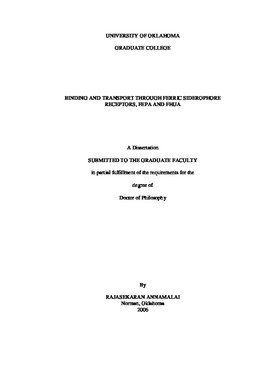| dc.contributor.advisor | Klebba, Phillip F., | en_US |
| dc.contributor.author | Annamalai, Rajasekaran. | en_US |
| dc.date.accessioned | 2013-08-16T12:20:09Z | |
| dc.date.available | 2013-08-16T12:20:09Z | |
| dc.date.issued | 2006 | en_US |
| dc.identifier.uri | https://hdl.handle.net/11244/1041 | |
| dc.description.abstract | Under iron deficient conditions, Gram-negative bacteria like E. coli secrete siderophores to chelate iron in the extracellular medium. Ligand-gated porins (LGPs) transport the ferric siderophore complexes across the outer membrane (OM) of the bacterium. The C-terminal domains of LGPs form channels across the OM, which are occluded by their N domains. The LGPs, FepA and FhuA transport ferric enterobactin (FeEnt) and ferrichrome (Fc) respectively into the periplasm of E. coli. | en_US |
| dc.description.abstract | The surface loops of FepA bind and enclose FeEnt at the top of the barrel. Site-directed mutagenesis studies show that aromatic residues like tyrosine 481 and 638 make a major contribution to the high affinity of the interaction. Intriguingly, some of the aromatic residues like tyrosines 478, 495 and tryptophan 101 although located in the outer reaches of the protein are crucial to the uptake reaction despite making only modest contributions to the binding reaction. | en_US |
| dc.description.abstract | The FeEnt-FepA binding interaction binding reaction is biphasic with two binding stages, B1 and B2 which may reflect two anatomical locations or two kinetic stages. The interaction is also specific and is characterized by high affinity. Binding competition experiments between FeEnt and other ferric siderophores show that the initial adsorption of the ligand happens with bonafide specificity. The interaction is unaffected by unrecognized ferric siderophores like ferrichrome and ferric Agrobactin. The triscatecholate and cognate siderophore, ferric TRENCAM competes with FeEnt. Despite being triscatecholate, ferric corynebactin only partially inhibits the binding of FeEnt. When compared to FeEnt, the iron center in ferric corynebactin has the opposite configuration of the chelating groups around the iron. Further more, the ferric siderophore is larger in size than FeEnt. The partial inhibition presumably reflects the fact that the molecule participates in the initial stage of binding, B1 but does not progress to B2 in the biphasic binding. | en_US |
| dc.description.abstract | Upon binding and closure of the loops, the N domain of FepA undergoes a conformational change to allow FeEnt to pass through the barrel. Labeling experiments with fluorophores and cysteine mutants of FepA show that this process involves the extrusion of the N domain from its location within the beta barrel. This is evidenced by the fact that G54C in the N domain is labelled during the transport, but G565C in the interior of the barrel is not labelled. The model of transport envisages the specific adsorption of the ferric siderophore followed by the closure of the loops over the bound ligand. Subsequently the N domain extrudes out of the barrel and FeEnt is transported into the periplasm. | en_US |
| dc.format.extent | xi, 138 leaves : | en_US |
| dc.subject | Chemistry, Biochemistry. | en_US |
| dc.subject | Escherichia coli. | en_US |
| dc.subject | Protein binding. | en_US |
| dc.subject | Siderophores. | en_US |
| dc.title | Binding and transport through ferric siderophore receptors, FepA and FhuA. | en_US |
| dc.type | Thesis | en_US |
| dc.thesis.degree | Ph.D. | en_US |
| dc.thesis.degreeDiscipline | Department of Chemistry and Biochemistry | en_US |
| dc.note | Source: Dissertation Abstracts International, Volume: 67-03, Section: B, page: 1421. | en_US |
| dc.note | Adviser: Phillip F. Klebba. | en_US |
| ou.identifier | (UMI)AAI3213384 | en_US |
| ou.group | College of Arts and Sciences::Department of Chemistry and Biochemistry | |
